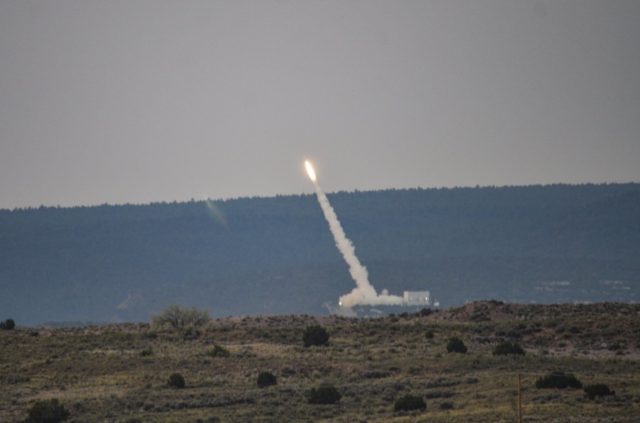The US Army’s Integrated Battle Command System (IBCS) has successfully intercepted a high-performance, high-speed tactical ballistic missile (TBM) target and a cruise missile target during its second Limited User Test (LUT) at White Sands Missile Range, New Mexico.
Like the first LUT flight test, the second test was conducted by soldiers from the US Army 3rd Battalion, 43rd Air Defense Artillery (ADA) Regiment. Their defense consisted of two battery and one battalion IBCS engagement operations centers, two Patriot and two Sentinel radars, and four launchers with a mixture of Patriot Advanced Capability Two (PAC-2), Patriot Advanced Capability Three (PAC-3), and Missile Segment Enhanced (MSE) interceptors connected to the IBCS integrated fire control network (IFCN).
The flight test started with the an MQM-178 cruise missile surrogate and Black Dagger/Boosted Zombie ballistic missile surrogate being launched from different points of origin toward the army defenders at the controls of IBCS. The TBM target was fired far from the missile range and traveled on a ballistic trajectory, while the cruise missile surrogate flew a low-altitude course.
As the target missiles traveled independently towards their targets, multiple disparate radars provided data to IBCS. IBCS integrated the data to form a single uninterrupted composite track of each threat, impossible with any single sensor, which then informed engagement solutions with the best interceptors to engage both incoming threats. The soldiers then executed the IBCS-enabled engagement, which included the launch of a PAC-2 to intercept the cruise missile and a PAC-3 to intercept the advanced TBM.
At the conclusion of the limited-user test in September, Army Test and Evaluation Command will look through terabytes of information to ensure that the system performed as expected. The data collected, combined with feedback from Soldiers and evaluation officials, will help shape future iterations of the IBCS.
The execution of back-to-back LUT flight tests move IBCS another step closer to Milestone C followed by production and fielding of IBCS. An initial operational capability is expected in 2022.
“It’s been amazing to watch our soldiers’ ability to successfully track, engage, and destroy multiple targets in a highly-complex live fire operational test, further demonstrating the IAMD’s game-changing technological advantage”, said Maj. Gen. Rob Rasch, Army Program Executive Officer, Missiles and Space.
“As we continue to fine-tune system performance in order to fully demonstrate system requirements in the initial operational test & evaluation in fiscal year 2022, we maintain high confidence for success due to the great leaders and soldiers of the 3-43, who will ultimately become the first-ever IBCS-enabled battalion.”
The new system will provide the army with an integrated command-and-control system, capable of blending current and future air and missile defense sensors and weapon systems under a unified network. IBCS enables battle survivable “any-sensor, best-effector” operations by fusing information from multiple, disparate sensors to create a single integrated air picture, and employing all available effectors to defeat advancing threats.



























